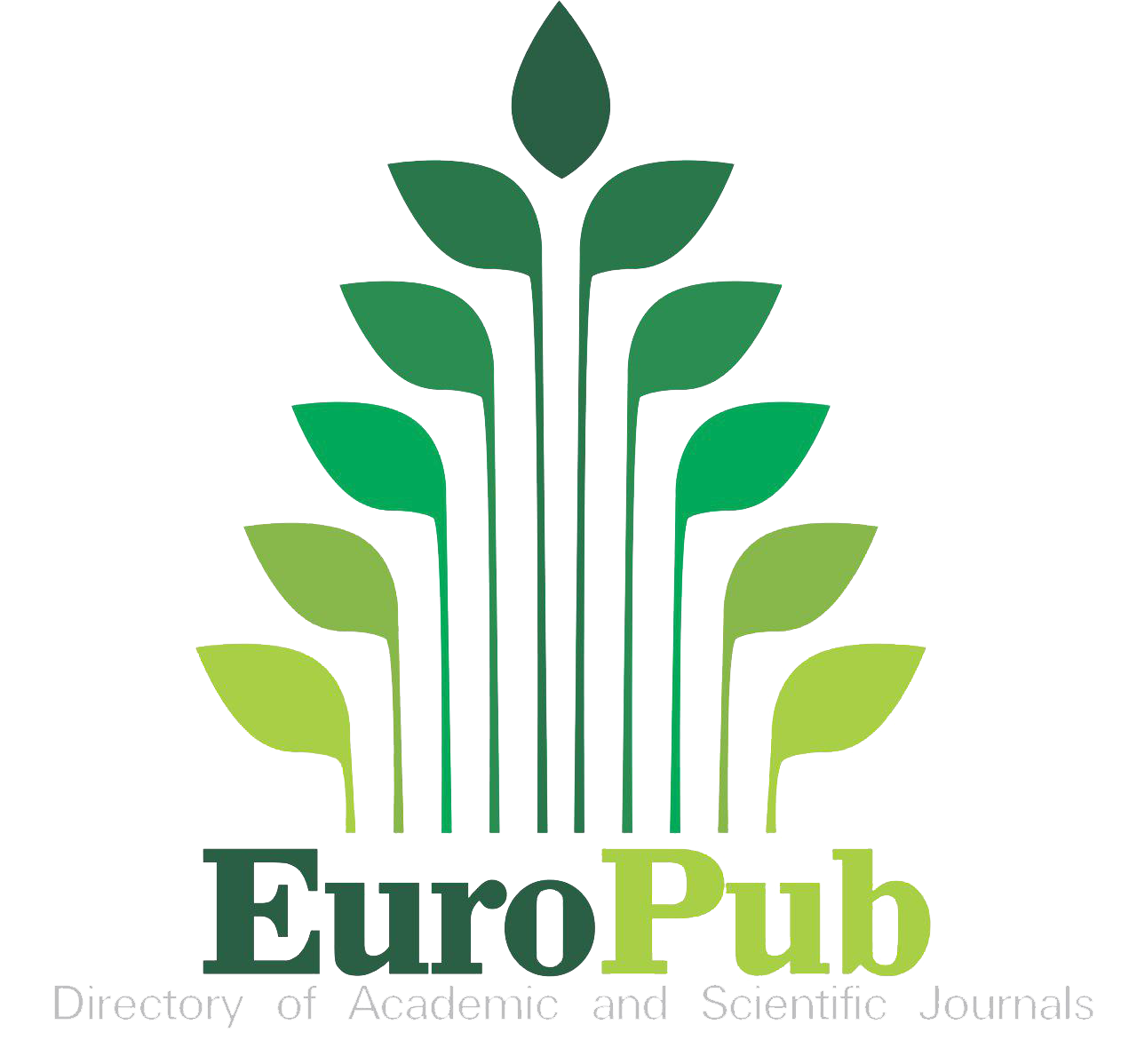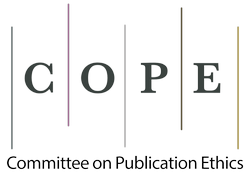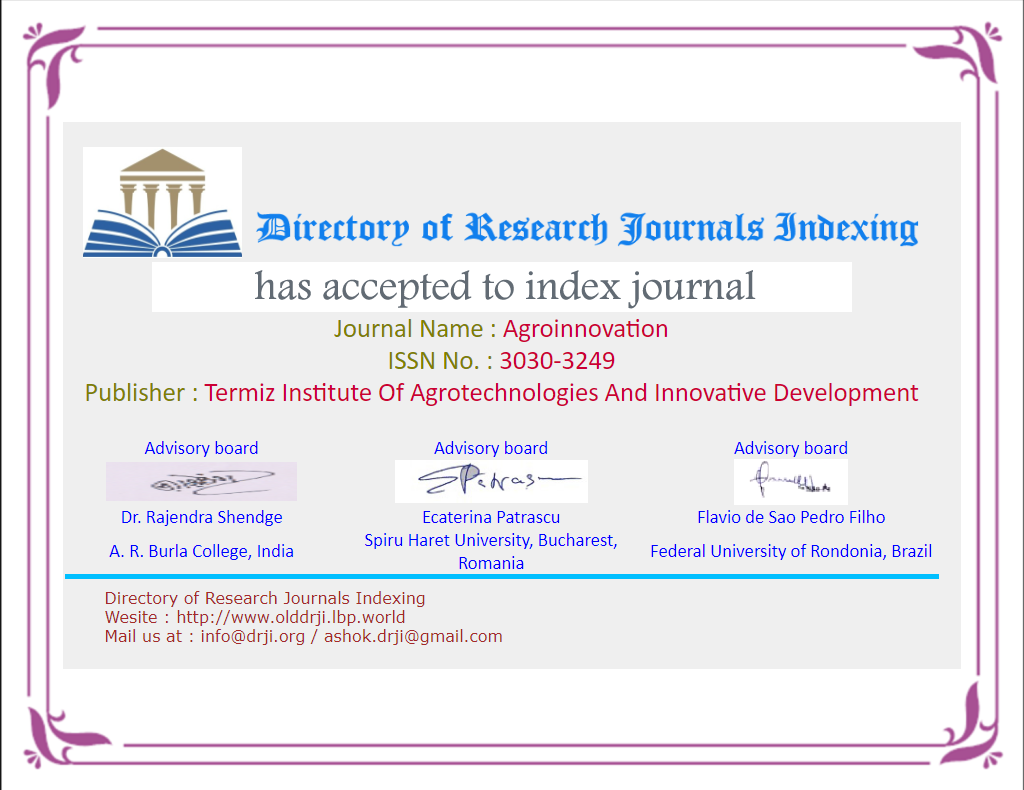SHO’RLANGAN TUPROQLAR VA TUZLARNING O’SIMLIKLARGA ZARARLI TA’SIRI.
Ключевые слова:
Засоление почв, причины засоления, вредные соли, растворимость солей, почвенный раствор, электропроводность, солеустойчивость растений.Аннотация
Площадь засоленных почв на орошаемых землях мира увеличивается. Для эффективного использования этих почв необходимо знать причины появления вредных солей в почве и их особенности, степень и виды засоления, а также вредное воздействие солей в почве на растения.
В данной статье изучен механизм токсического действия солей этой почвы на растения, устойчивость сельскохозяйственных культур.
Скачивания
Библиографические ссылки
Acevedo, E., Silva, P., and Silva, H. (2002). Wheat growth and physiology. In: Curtis,B.C., S.Rajaram and H. G. Macpherson (Eds.) Bread Wheat Improvement and Production, FAO Plant Production and Protection Series, No. 30. Food and Agriculture Organization of the United Nations, Rome, Italy.
Al Hinai, M. S., Ullah, A., Al-Rajhi, R. S., & Farooq, M. (2022). Proline accumulation, ion homeostasis and antioxidant defence system alleviate salt stress and protect carbon assimilation in bread wheat genotypes of Omani origin. Environmental and Experimental Botany, 193: 104687.
Dourado, P. R. M., de Souza, E. R., Santos, M. A. D., Lins, C. M. T., Monteiro, D. R., Paulino, M. K. S. S., & Schaffer, B. (2022). Stomatal Regulation and Osmotic Adjustment in Sorghum in Response to Salinity. Agriculture, 12(5): 658.].
Eaton 1966; Grundon 1987; Kurniadie and Redmann 1999; Xu et al. 2000 Eaton FE (1966) Chlorine. In 'Diagnostic criteria for plants and soils'. (Eds. HD Chapman.) pp. (Division of Agricultural Science, University of California
Ehtaiwesh, A. and Rashed, F. (2020). Growth and yield responses of Libyan hard wheat (Triticum durum desf) genotypes to salinity stress. University of Zawia Bulletin. 22(2):33-58.
Giuffrida, F., Carla, C., Angelo, M., Cherubino, L. (2016). Effects of salt stress imposed during two growth phases on cauliflower production and quality. Journal of Science and Food Agriculture.97: 1552-1560.
Giuffrida, F., Scuderi, D., Giurato, R. Leonardi, C. (2013). Physiological response of broccoli and cauliflower as affected by NaCl salinity. Acta Horticulturae. 1005: 435-441.
Hussain, S., Shaukat, M., Ashraf, M., Zhu, C., Jin, Q., & Zhang, J. (2019). Salinity Stress in Arid and Semi-Arid Climates: Effects and Management in Field Crops. In (Ed.), Climate Change and Agriculture. IntechOpen. https://doi.org/10.5772/intechopen.87982
Ismail AM, Horie T. Genomics, physiology, and molecular breeding approaches for improving salt tolerance. Annual Review of Plant Biology. 2017 Apr; 68:405-34.
Katarzyna Negacz, Ziga Malek, Arjen de Vos,Pier Vellinga “Saline soils worldwide: Identifying the most promising areas for saline agriculture” Journal of Arid Environments. Volume 203,August 2022
Kenneth K. Tanji, Neeltje C. Kielen. Agricultural Drainage Water Management in Arid and Semi-Arid Areas. FAO irrigation and drainage paper 61. Rome-2022. Cahpter 4.
Magistad O.C., and Reitemeier R. F. Composition and characteristics of soil solutions from normal and saline soils at low soil moisture contents. (Unpublished.)
Maas, E.V., Hoffman, G.J., Chaba, G.D., Poss, J.A., and. Shannon. M. C. (1983). Salt sensitivity of corn at various growth stages.Irrigation.Science.4:45–57.
Muxammedov A.Q. “Melioratsiya asoslari” O’quv qo’llanma. Toshkent-2008. 99-102 b.
Munns, R., M. Gilliham. (2015). Salinity tolerance of crops – what is the cost? New Phytologist. 208(3): 668-673.
Rengasamy, P. (2006). World salinization with emphasis on Australia. Journal of Experimental Botany.5: 1017–1023. Munns R. (2002). Comparative physiology of salt and water stress. Plant and Cell and Environment.25: 239–250.
Shahbaz, M. M. Ashraf. (2013). Improving salinity tolerance in cereals. Journal Critical Reviews in Plant Sciences.32: 237-249.
Tursunov I. va boshqalar “Tuproq fizikasi”. Darslik. T-2014. 244-257-b.
Xoliqulov Sh, Uzoqov P, Boboxo’jayev I. Tuproqshunoslik. Darslik. T-2011. 348-368 b
Yuan, C. F., Feng, S. Y., Wang, J., Huo, Z. L., and Ji, Q. Y (2018). Effects of irrigation water salinity on soil salt content distribution, soil physical properties and water use efficiency of maize for seed production in arid Northwest China. International Journal of Agricultre & Biological Engenering, 11 (3): 137–145.]
Zahra N, Mahmood S, Raza ZA. Salinity stress on various physiological and biochemical attributes of two distinct maize (Zea mays L.) genotypes. J Plant Nutr. 2018 Jul; 41(11):1368-80.]
Woodrow, P. et all. (2016). Durum wheat seedling responses to simultaneous high light and salinity involve a fine reconfiguration of amino acids and carbohydrate metabolism. Physiology of Plant.159: 290-312.
Акиншина Н.Г. Қорақалпоғистонда экинларни деверсификатсиялаш учун шўрга чидамли ўсимликлар. 2-3 б.
Ковда В.А. Проблемы опустынивания и засоления почв аридных регионов мира. - Москва: Изд-во “Наука”, 2008. - 415 с.
Маслов Б.С., Минаев И.В., Губер К.В. Справочник по мелиоратсии. - Москва: “Росагропромиздат”,1989. - 383 с.
Расулов А.М. Повышение плодородия почв хлопковой зоны. - Москва: Изд-во “Колос”, 1976.- 220 с.
Турдалиев Ж.М ва бошқалар “Тупроқ шўрланиши, шўрланган тупроқлар ва тузларнинг ўсимликларга кўрсатадиган таъсири” O‘ZBEKISTON ZAMINI журнали. 2022 й.№ 2. 40-45 б.
Загрузки
Опубликован
Выпуск
Раздел
Лицензия

Это произведение доступно по лицензии Creative Commons «Attribution» («Атрибуция») 4.0 Всемирная.


























